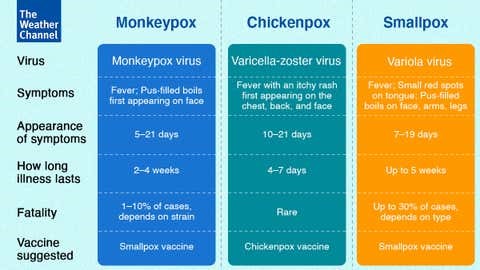Monkeypox vs Chickenpox vs Smallpox
Monkeypox vs Chickenpox vs Smallpox

Just when the world was hoping to bid adieu to COVID-19, another infection triggered by the monkeypox virus seems to have begun doing the rounds across the world. While it is unlikely to turn as infectious as the novel coronavirus, nearly 100 monkeypox cases have already been detected in over 12 countries so far.
The virus isn’t new — its existence was identified back in 1958, while the first human infection was described in 1972. Since then, multiple monkeypox outbreaks have been reported from several countries.
And now, its sporadic outbreak — especially during a pandemic — has sent the alarm bells ringing across the globe. While information on monkeypox itself is readily available, confusion still lingers about how it differs from similar infections like chickenpox and smallpox.
What’s with their names?
- Let’s split the word ‘monkeypox’ in half to understand its etymology. While monkeys aren’t exactly the culprits to blame, the virus was first identified in a monkey colony used for research in 1958. And pox refers to any disease that produces a rash of pimples that become pus-filled and leave pockmarks on healing. Hence the name ‘monkey-pox’.
- Similarly, chickenpox has nothing to do with chickens. There are two theories behind the naming of the disease: the first suggests that when the disease was discovered, the blisters on the diseased person looked similar to chickpeas; the other indicates that the rashes looked like peck marks caused by a chicken.
- As for smallpox, the ‘small’ was used to distinguish it from syphilis (also recognised by rashes), which was called ‘greatpox’ in the 16th Century.
How can one differentiate a monkeypox infection from chickenpox or smallpox?
- The symptoms of monkeypox are quite similar to those of chickenpox and smallpox, thus making it tricky to tell them apart.
- Like smallpox, monkeypox results in pus-filled boils after its incubation period. However, the pain is milder and gets better within 2-4 weeks without treatment. Moreover, as per the WHO, monkeypox is less contagious and fatal than smallpox.
- According to the U.S. CDC, the main difference between the symptoms of smallpox and monkeypox is swollen lymph nodes or “lymphadenopathy” — monkeypox causes lymph nodes to swell, while smallpox doesn’t.
- Although the chickenpox blisters are similar to both smallpox and monkeypox, they become itchy rather than painful, and appear first on the chest, back and face.
For how long does each disease last?
- While monkeypox and smallpox may persist for up to 4-5 weeks, chickenpox survives for only a week in the human body.
Are these diseases fatal?
- None of these infections are highly fatal. However, the patients have lost their lives in 1-10% of monkeypox cases and 30% of smallpox cases.
- With smallpox being eradicated from India, the hope is that we will be better prepared if at all the virus attacks the nation.
Who can contract these diseases?
- While anybody can contract either of the viral diseases, the WHO states that the recent spread of monkeypox has been especially frequent via sexual contact among homosexual men.
Why are doctors suggesting the smallpox vaccine for monkeypox?
- Both monkeypox and smallpox belong to the same family of viruses, and they share similar symptoms as well. Due to these very facts, smallpox vaccines have already been effectively used against monkeypox infections.
- The smallpox vaccine itself is developed from a virus called vaccinia, which is a pox virus similar to smallpox, but less harmful. Data suggests that the smallpox vaccine is at least 85% effective in preventing monkeypox as the subsequent immunity is also believed to be long lasting says experts.

